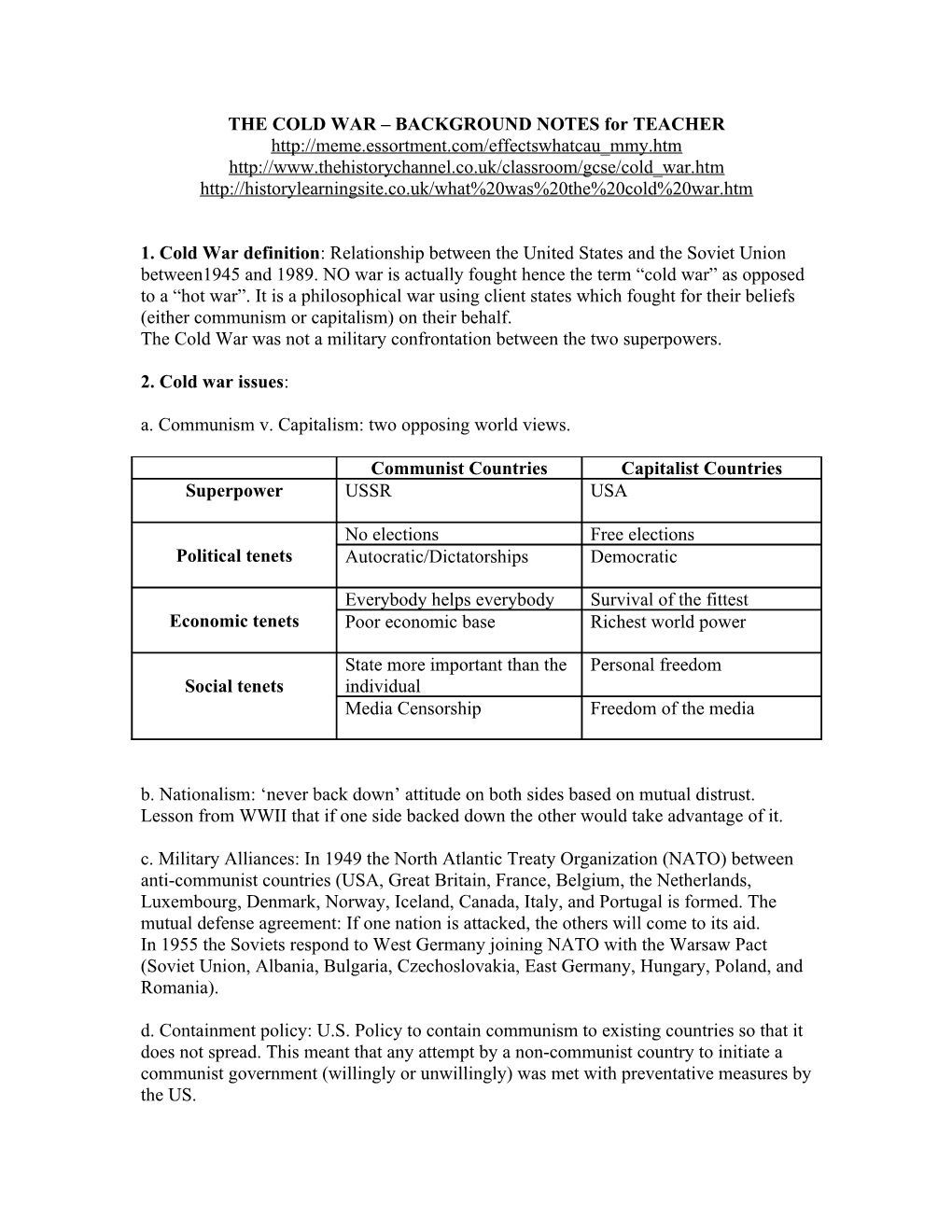THE COLD WAR – BACKGROUND NOTES for TEACHER
1. Cold War definition: Relationship between the United States and the Soviet Union between1945 and 1989. NO war is actually fought hence the term “cold war” as opposed to a “hot war”. It is a philosophical war using client states which fought for their beliefs (either communism or capitalism) on their behalf.
The Cold War was not a military confrontation between the two superpowers.
2. Cold war issues:
a. Communism v. Capitalism: two opposing world views.
Communist Countries / Capitalist CountriesSuperpower / USSR / USA
Political tenets / No elections / Free elections
Autocratic/Dictatorships / Democratic
Economic tenets / Everybody helps everybody / Survival of the fittest
Poor economic base / Richest world power
Social tenets / State more important than the individual / Personal freedom
Media Censorship / Freedom of the media
b. Nationalism: ‘never back down’ attitude on both sides based on mutual distrust. Lesson from WWII that if one side backed down the other would take advantage of it.
c. Military Alliances: In 1949 the North Atlantic Treaty Organization (NATO) between anti-communist countries (USA, Great Britain, France, Belgium, the Netherlands, Luxembourg, Denmark, Norway, Iceland, Canada, Italy, and Portugal is formed. The mutual defense agreement: If one nation is attacked, the others will come to its aid.
In 1955 the Soviets respond to West Germany joining NATO with the Warsaw Pact (Soviet Union, Albania, Bulgaria, Czechoslovakia, East Germany, Hungary, Poland, and Romania).
d. Containment policy: U.S. Policy to contain communism to existing countries so that it does not spread. This meant that any attempt by a non-communist country to initiate a communist government (willingly or unwillingly) was met with preventative measures by the US.
e. Client States: The support of other countries by the two superpowers in their desire to introduce a democratic or communist government into those client states. Wars between client states resulted in Vietnam (1954-1975), Korea (1950-1953), Angola (1975), Nicaragua (1979), and Afghanistan (1979-.
Conflict / USSR support / USA support / OutcomeVietnam / North supported by China / South supported slowly before full support in mid-1960s / War unpopular in the USA. US withdrew support after Paris Accords (cease fire) signed. North invaded South and took over. Unified Vietnam resulted.
Korea / North as legal government Korea / South as legal government of Korea / Stalemate (States maintained separate governments)
Angola / Arms and support to Marxist faction / Arms and support / Marxist faction in power
Nicaragua / Sandanista Revolutionaries / Contras guerrilla group / Stalemate
Afghanistan / Soviets invade in 1979 / Rebel groups / War unpopular in USSR
f. Satellite States: The Berlin wall (1961) went up dividing Germany into two parts – one part supported by communism (and next to the USSR), the other by capitalism. The non-tangible “Iron curtain” was created in which Russia enveloped smaller countries (known as satellites) just outside its borders to buffer against capitalist and socialist countries. The Cuban Missile Crisis (1962) was when USSR came into Cuba to build armaments in support of Communist Cuba. They left without doing so.
g. Arms Race: Russia upset that USA ‘secretly’ built the atomic bomb leading to a healthy distrust of the USA. Both sides built inter-Continental Ballistic Missiles (ICBMs) that could wipe out each other and the entire world. The race for having the most destructive weapon continued to see-saw.
h. Space Race: Power gambit to showcase technological advancements. Begins when the Russians are the first to put a space ship in outer space with the Launching of Sputnik 1 (space satellite). The US meets the challenge by putting the first person on the moon.
i. Economic implications: To the United States, Communism was a threat to US business since communist countries would not purchase products from the US. This scared the USA since they did not want to experience another depression. To Russia, it had suffered enormous destruction during WWII with a loss of 25 million citizens and was determined that it would never be invaded again. It did so by buffering itself with Eastern European countries (Poland, E. Germany, Hungary, Romania, Bulgaria, and Czechoslovakia), creating the USSR.
j. Preventative measures: A hotline was set-up between the US and the USSR and a treaty (Nuclear Test-Ban Agreement 1963) was signed by both counties to reduce risk of accidental nuclear war and to end nuclear testing.
3. Why did the Cold War happen?
The Cold War was a ‘fight’ over land and philosophy. This is seen through the US containment policy to stop communism from spreading to other countries. Obviously, the USSR wanted to convert as many countries to its philosophy. The US wanted to stop the spread of it.
Another reason it happened was because there was concern over the idea of a nuclear war. A nuclear war would be devastating to land, lives, and other animals. So an arms race began in which both superpowers competed technologically to keep up with each other. This way, no one had the
